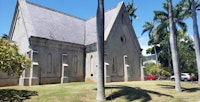At the top of Nuuanu Avenue, about a mile and a half from the bustle of Downtown Honolulu, Oahu visitors can visit the Royal Mausoleum. Known as “Mauna Ala” in the Hawaiian language, it is the final resting place of many members of Hawaii’s royal family and retainers. It is an excellent way to experience the great dignity of a monarchy and kingdom now long gone. It is home to the most important figures in Hawaii history.
It is a quiet and contemplative place. Mauna Ala means “fragrant hills” in Hawaiian. Often, visitors are treated to the sweet smells of lemon grass and plumeria blossoms blowing in on the gentle trade winds that flow out of Nuuanu Valley. Stately royal palms ring the modest chapel, rustling in the breeze. Monuments to beloved family members dot the relatively small piece of property (2.7 acres).
There are two crypts at Mauna Ala, home to the earthly remains of members of the Kamehameha and Kalakaua royal dynasties and their close family members. It is on the U.S. National Registry of Historic Places. It shares a similar distinction with Iolani Palace, the only royal palace in the United States. Mauna Ala is the only royal mausoleum in the US.
We blog about Hawaii
because we love Hawaii.
The first section of Mauna Ala was built in 1864 by order of King Kamehameha V. The first to be interred there was the 4-year old son of Queen Emma and King Kalakau. Many of the remains at Mauna Ala were transferred there from another mausoleum near Iolani Palace, which had reached its capacity.
Queen Kaahumanu, wife of King Kamehameha the Great, is buried at the Royal Mausoleum. Out of religious practice, the King’s remains were spirited away to a secret location that will likely never be known. His descendants (King Kamehameha II-V) are interred at Mauna Ala.
Among the many dozens of notable historic figures of Hawaii royal ancestry at Mauna Ala is King David Kalakaua (Kamehameha IV), who was voted king by the Hawaiian Legislature in 1874. His love for his Hawaiian culture and arts led to his being known as the “Merrie Monarch”.
Mauna Ala is also the perpetual home of beloved Queen Kapiolani, Queen Liliuokalani (overthrown in 1893) and her husband John Dominis, Prince Jonah Kuhio (nephew to King Kalakaua), and dozens of other important figures in the rich history of the monarchy of the Kingdom of Hawaii before and after its overthrow.
The area around Mauna Ala is quiet and serene. The Nuuanu neighborhood is also home to historic Oahu Cemetery and a Japanese cemetery, just steps away from the entrance to Mauna Ala. It is an easy spot for a picnic lunch (pack your trash!) or a leisurely stroll for Oahu visitors crossing the Pali Highway in either direction.
With the Pali returning to normal after a closure following a devastating landslide during heavy rains earlier this year, it’s more accessible than it has been for months. There really aren’t many western architecture structures remaining that date directly back to the Hawaiian Kingdom. However, the Queen Emma Summer Palace is about a mile up the Pali Highway and is also worth a visit.
Hawaii Aloha Travel’s local experts can help you plan a stop at the Royal Mausoleum, or Mauna Ala, with plenty of time left over to enjoy the myriad treasures of Oahu, “the Gathering Place”.







